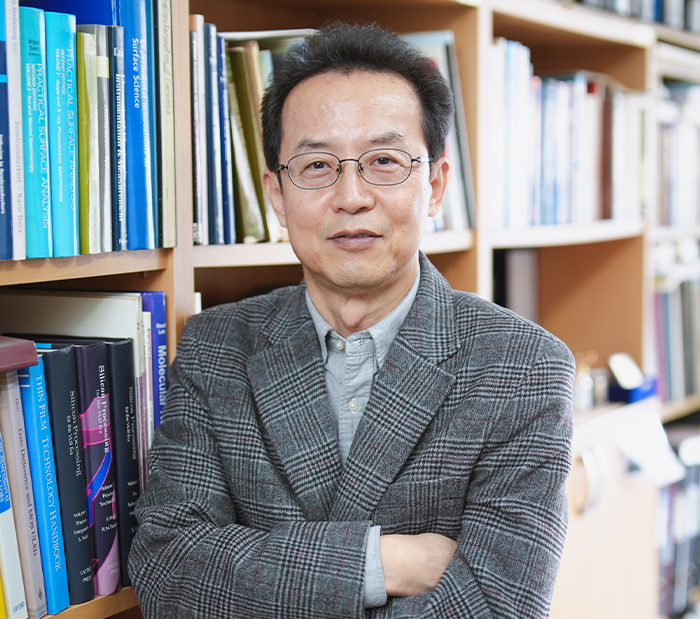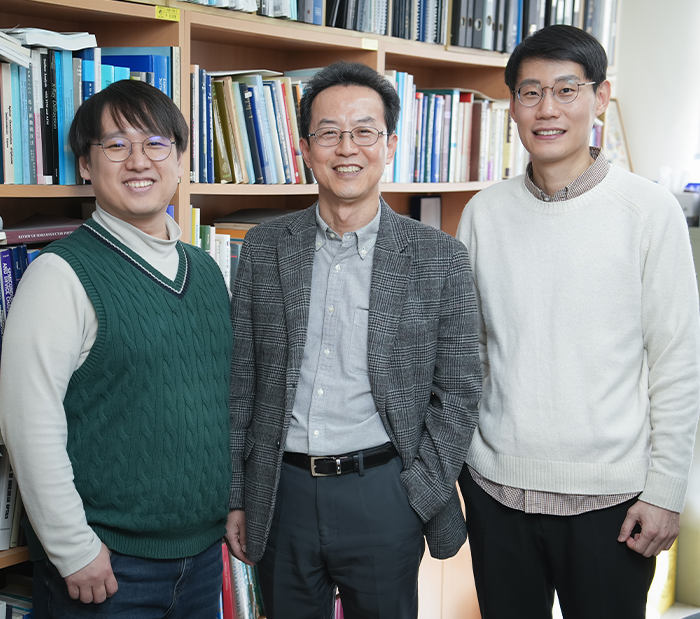Predicting and demonstrating of hidden metastable phase in transition metal oxide
Advanced Materials Science and Engineering LEE, JAICHAN Prof. · Bongwook Chung
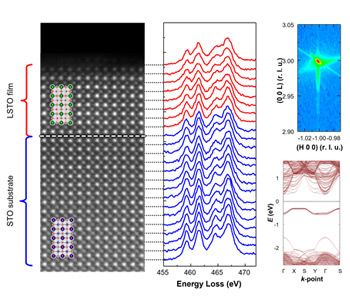
-
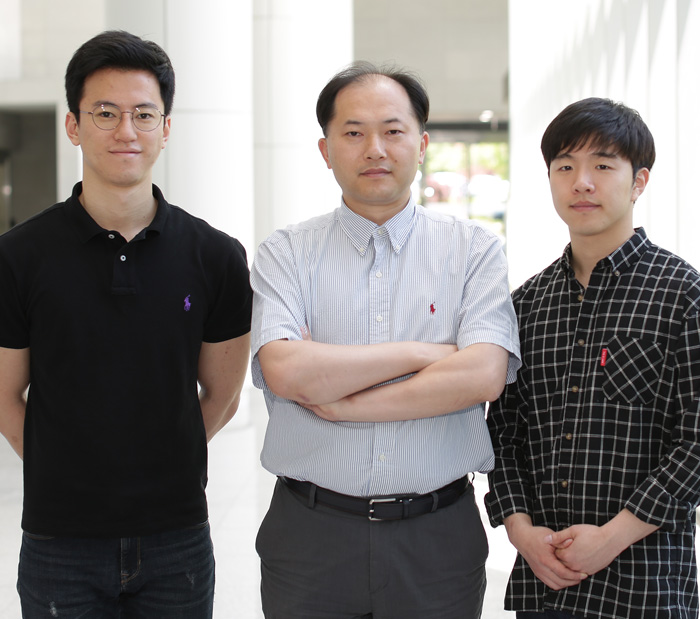
Energy Science JEONG, MUNSEOK Prof.
SKKU Research Team Successfully Demonstrated The Structure of Grain Boundary
A research team led by Prof. Mun Seok JEONG from the Department of Energy Science of SKKU and the researcher Kyung Duk PARK from Colorado State University, successfully demonstrated the structure of grain boundary which is one of the main defects that cause a decrease in the quality of graphene. Though structural, chemical, and optical analysis, the team claimed that they confirmed that the structure of graphene is composed of two layers. Besides the grain boundary, they also succeeded with Nano Raman Imaging of nano wrinkle and seed later, which is expected to increase the understanding of the growth mechanism of graphene.
- No. 42
- 2018-07-05
- 1809
-
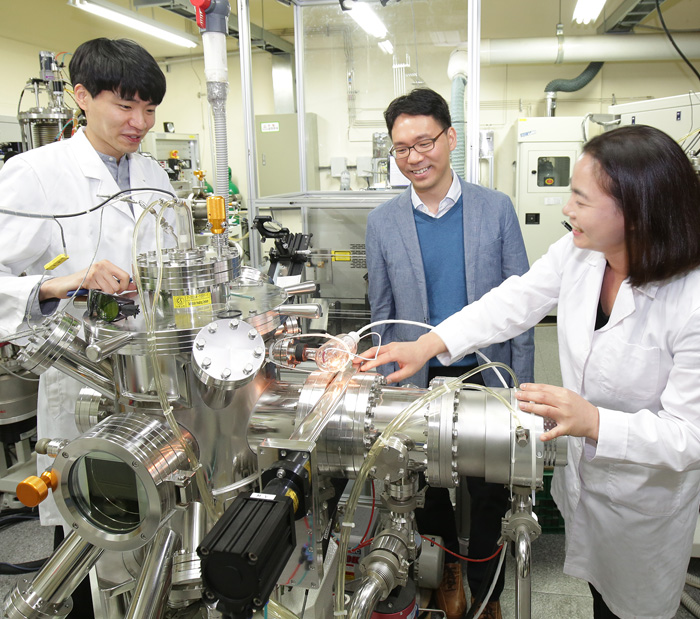
Physics CHOI, WOOSEOK Prof.
Enhanced electrocatalytic activity via phase transitions in strongly correlated SrRuO3 thin films
Recent demand for sustainable energy sources have led to active research on advanced materials/devices. Electrochemical catalytic activity is one of the key mechanisms for fuel cell and hydrogen storage operation. Yet, the fundamental understanding of the oxygen evolution reaction (OER) is rather limited so far. The research team led by Prof. CHOI focused on fabrication of high quality single crystalline transition metal oxide thin film samples to unveil the fundamental physical/chemical mechanism for the OER activity. Introducing atomic-level control of elemental defects during pulsed laser epitaxy (PLE), a strong correlation between the lattice/electronic structure and electrocatalytic activity could be deduced. In particular, the structural phase transition from an orthorhombic to a tetragonal perovskite SrRuO3 resulted in substantial modification in the electronic structure, which led to a 30% reduction in the overpotential for the OER activity. Such change was explained systematically, in terms of hybridization within the Ru-O network, as well as the adsorption probability of oxygen or hydroxyl molecules. Based on this study, the strong correlation within the perovskite oxides which is the key ingredient for many intriguing emergent phenomena, is also considered as an essential part for the energy conversion mechanism. In addition, the study provides microscopic approach in studying the energy-related behavior. This research was published in April issue of Energy & Environmental Science.
- No. 41
- 2018-07-05
- 1714
-
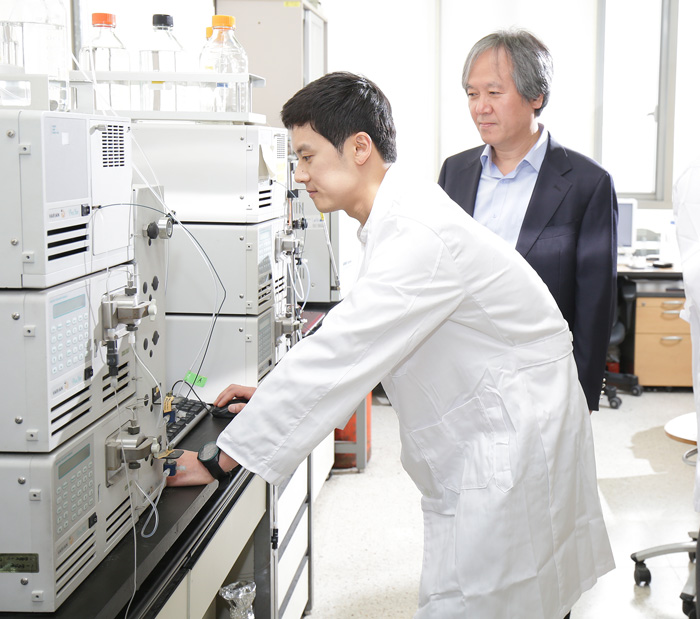
Chemistry SONG, CHOONGEUI Prof.
Biomimetic Organocatalysis : Towards “Ideal” Catalysis
Through millions of years of evolution, nature has accomplished the development of the ideal catalysts called enzymes that catalyze the biological chemical reactions necessary to sustain all life on Earth. Thus, lessons from how natural enzymatic systems operate can therefore be very important for the design of the more efficient and environmentally benign catalytic systems. Prof. Choong Eui SONG and his students (Department of Chemistry) successfully developed biomimetic catalytic transformation of toxic α-oxoaldehydes to high-value chiral α-hydroxythioesters using artificial glyoxalase I. This reaction is exceptionally enantioselective and the α-hydroxythioester products are of high value for multiple synthetic applications. The synthetic applicability was highlighted by the coupling reagent-free synthesis of several optically pure α-hydroxyamides, highly important drug candidates in the pharmaceutical industry. Moreover, his group made the important scientific discovery that water enables new catalytic reactions for otherwise unreactive substrate systems. Enantioselective Michael addition of extremely unreactive α,α-disubstituted β-nitroalkenes with malonate derivatives using hydrophobic catalysts, affording both enantiomers of highly enantio-enriched Michael adducts with all-carbon-substituted chiral quaternary centers, has been achieved for the first time. The reaction was made possible by the “on water condition,” which enables enforced hydrophobic interactions between catalysts and substrates due to hydrophobic hydration effects. Developed water protocol was successfully applied for the scalable one-pot syntheses of chiral GABA analogues bearing all-carbon quaternary stereogenic centers at the β-position that might show highly interesting pharmaceutical properties. These results were recently published in the world top journals Nature Communications and Angewandte Chemie International Edition. * Related papers: 1) “Biomimetic catalytic transformation of toxic-oxoaldehydes to high-value chiral α-hydroxythioesters using artificial glyoxalase I” – Nat. Commun. 2017, 8, 14877. 2) “Water-enabled catalytic asymmetric Michael reactions of unreactive nitroalkenes: One-pot synthesis of chiral GABA-analogs with all-carbon quaternary stereogenic centers” – Angew. Chem. Int. Ed. 2017, 56, 1835 (as a Hot Paper).
- No. 40
- 2018-07-05
- 2003
-
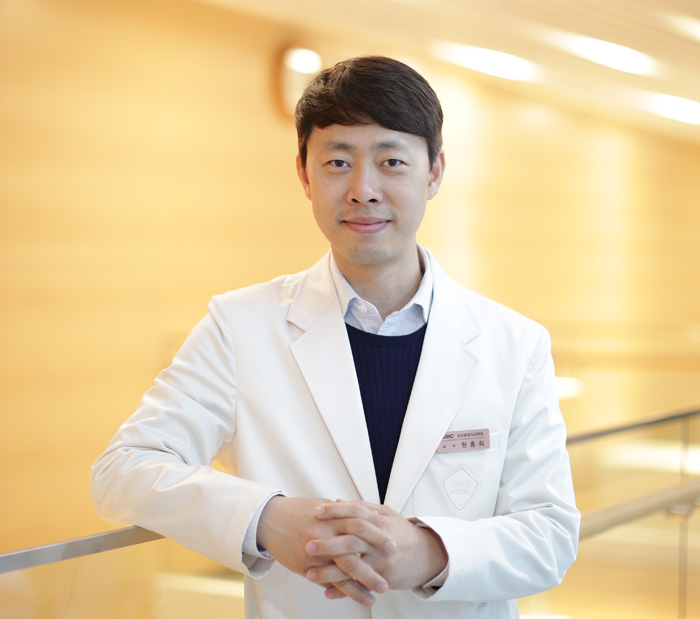
Samsung Advanced Institute for Health Sciences and Technology, SKKU WON, HONG HEE Prof.
Discovery of Rare Damaging Mutations Associated with Coronary Artery Disease
Rare damaging mutations that are highly associated with increased triglyceride levels and presence of coronary artery disease (CAD) were identified by an SKKU and Harvard Medical School joint research team. Together with Drs. Amit KHERA and Sekar KATHIRESAN (Massachusetts General Hospital, Harvard Medical School and Broad Institute), Prof. Hong Hee WON in Samsung Advanced Institute for Health Sciences and Technology (SAIHST) at SKKU and Samsung Medical Center analyzed DNA sequences of the lipoprotein lipase (LPL) gene of 46,891 individuals. In this cross-sectional study of CAD casecontrol studies, gene sequencing identified a damaging mutation in the LPL gene in 188 of 46,891 individuals (0.4%). These mutations were associated with an increase of 19.6mg/dL in plasma triglycerides. In particular, these mutations were associated with increased odds of early-onset CAD with an odds ratio of 1.84. This research team previously published that rare mutations in the APOC3 (NEJM 2014), APOA5 (Nature 2015), ANGPTL4 (NEJM 2016) genes associated with plasma triglycerides and risk for CAD. These genes are known to be involved in hydrolyzing triglycerides in lipoproteins in the LPL pathway. “We, as a team, pursue successful combinations of advanced informatics skills and biomedical technologies to understand the genetic bases of human disease and improve healthcare,” Prof. WON mentioned. “In order to prevent cardiovascular disease, it is very important to control plasma triglyceride levels as well as LDL cholesterol. I hope this finding leads to the development of drugs for targeting LPL and related proteins and controlling triglycerides so that it can help maintain people’s health by preventing cardiovascular disease.” This research was published in the Journal of American Medical Association (JAMA) in 2017, with the title of “Association of Rare and Common Variation in the Lipoprotein Lipase Gene with Coronary Artery Disease.”
- No. 39
- 2018-07-05
- 1698
-
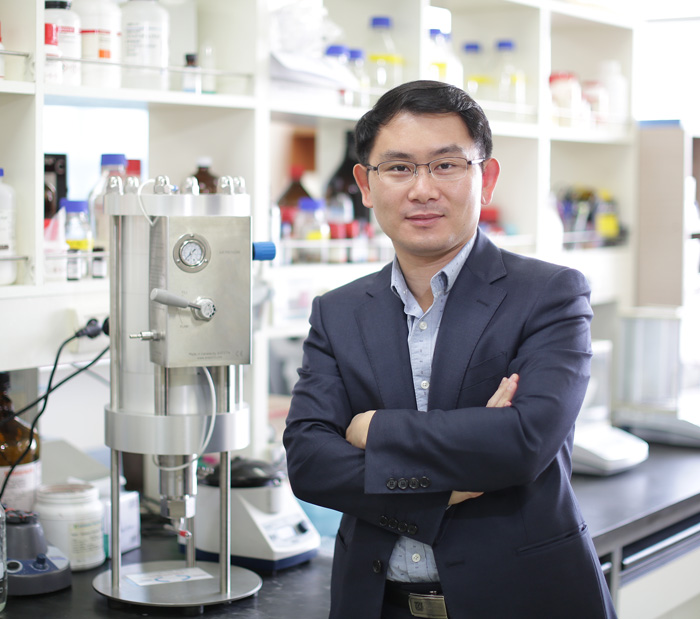
Pharmacy YOUN, YU SEOK Prof.
Photothermal Therapy for Brain Tumors Using a Rabies Virus-Mimetic Gold Nanorods Platform
Professor Yu Seok YOUN (School of Pharmacy) has developed a brain tumor-targeting treatment and photothermal therapy using gold nanorods that mimic the actual body of the rabies virus. A brain tumor (glioblastoma) is one of the most fatal types of cancer because patients with it have a very short average survival rate of 14.6 months. Many researchers have had great difficulty developing an effective therapeutic because of the dense brain capillary endothelial structure, so-called, blood-brain barrier (BBB), which is considered to be a crucial hurdle for the treatment of brain tumors. To solve this problem, the research team suggested a unique platform of rabies virus-mimetic gold nanorods (AuNRs) that have the ability to reach the brain tumors by bypassing the BBB. These AuNRs emitted heat (~50°C) in response to the irradiation of near infrared (NIR) light and thus suppressed tumor growth. In detail, the research team has designed and fabricated a unique gold nanorod structure that closely mimics many features of the rabies virus, such as its size, shape, and surface morphologies, for the purpose of enhancing the ability to target brain tumors. The rabies virus causes deadly symptoms such as hydrophobia and encephalomyelitis when humans are infected by it. However, the rabies virus has special ability to enter the central nervous system (CNS) and eventually bypass the BBB and reach the brain tumor site because rabies virus glycoprotein (RVG) specifically binds to the nicotinic acetylcholine receptors present in the human body (Figure 1). In particular, the unique shape of the rabies virus, which is like a bullet or rod, is advantageous for neuronal pathway migration and it is characterized by its ability to penetrate into the CNS. To achieve this strategy, the team fabricated gold nanorods of 80 nm / 20 nm in size (length and width, respectively), to maintain an aspect ratio (AR = length/width: ~4.0) that reacts efficiently to NIR (808 nm). The resulting AuNRs was serially coated by silica and RVG to form a 120 nm / 50 nm nanostructure (AR: 2.34) with very similar size, shape, and surface characteristics to the rabies virus (AR: 2.4) (Figure 1). The prepared gold nanorods displayed remarkable penetration into the brain tumor cells (N2a) when comparing spherical gold nanoparticles with RVG or gold nanorods without RVG, and reached the brains of mice through the CNS as if it was an actual rabies virus. Consequently, the NIR irradiation (808 nm) resulted in increasing tumor temperature (~50°C) and effectively suppressed tumor growth in the N2a cell-inoculated mice (Figure 2). A brain tumor target therapeutic agent has been proposed by a paradoxical strategy of creating gold nanorods mimicking the biological characteristics of the rabies virus known to be very dangerous to humans. However, there are many steps that need to be overcome for FDA approval of clinically applicable anti-brain tumor nanodrugs. Therefore, interest and research of scientists in related fields are urgently needed, and the importance and value of the development of nanodrugs should be highly evaluated. The results of this study were published in the world's leading authoritative journal Advanced Materials Online (January 30, 2017) and shown in an article in Science/AAAS Magazine Online (February 10, 2017) entitled "How to Stop Brain Cancer with Rabies”. ※Information about the research paper - Title: Rabies Virus-Inspired Silica-Coated Gold Nanorods as a Photothermal Therapeutic Platform for Treating Brain Tumors - Authors: Changkyu LEE (first author, Ph.D. candidate), Ha Shin HWANG, Sungin LEE, Bomi KIM (co-authors, master course), Yu Seok YOUN (corresponding author, professor)
- No. 38
- 2018-07-05
- 2180
-
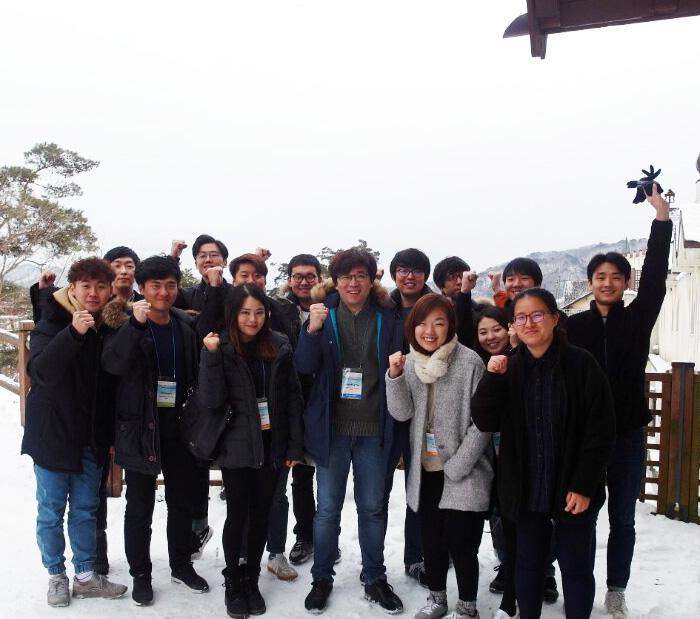
Energy Science KIM, SUNG WNG Prof.
Research on New Electro-active Energy Materials
Electro-Active Energy Material Lab. of the Department of Energy Science studies various materials related to energy conversion, magnetism, catalyst and electronics. They are targeting the first discovery and global-top performance in electrides as new electro-active materials and focusing on the development of record-high performance thermoelectric energy conversion materials. Also, they are studying low-dimensional transition metal dichalcogenides from fundamentals to applied researches. Followings are the main research topics: 1. Electrides: Electrides are ionic compounds in which electrons act as anions occupying interstitial real space of crystal structures, not orbitals. Because the electrides show a low work function and high electron concentration, the materials are of interest for electronics and catalysts. The research team designs and synthesizes new electrides by theoretical and experimental researches for industrial applications. 2. Thermoelectric materials: Thermoelectric materials can convert electricity to heat and vice versa. Utilizing the Seebeck and Peltier effect, thermoelectric refrigeration and power generation are possible to enable efficient energy consumption. The team is developing a world-record high performance in state-of-the-art materials by studying fundamental material physics and material process. 3. Low-dimensional materials: The low-dimensional transition metal dichalcogenides utilizing a high quality single crystal and epitaxial thin film are fabricated in their laboratory. Beyond graphene, the research team explores a new two-dimensional crystal structure distinct from conventional layered structures.
- No. 37
- 2018-07-05
- 1881
-
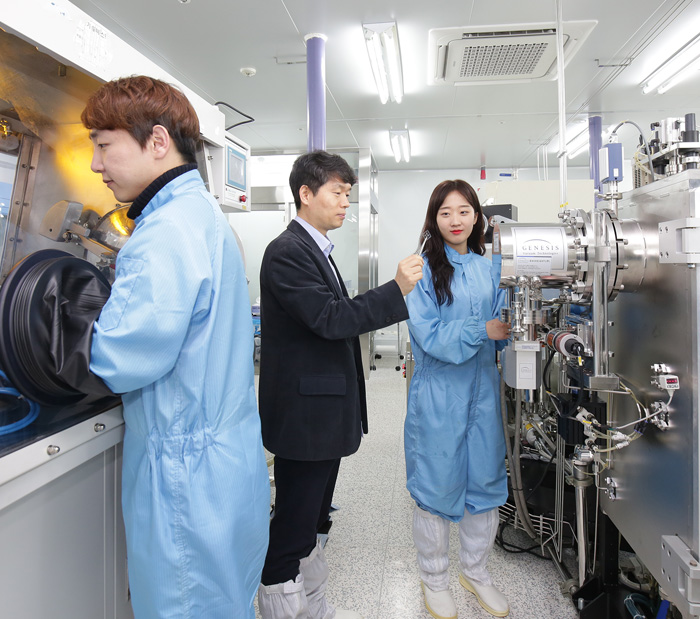
Electronic and Electrical Engineering SONG, JANG KUN Prof.
Research on Future Display using 2D Colloid Materials
The research team reported in Nature Materials in 2014 that 2D nano colloid can be used in liquid crystal display. In the conventional LCD devices, high electric fields over 1 V/μm is required to induce dynamic switching of liquid crystal molecules. In contrast, the team discovered that the electric field required for the switching of graphene-oxide (GO) 2D colloid was about 0.01 V/μm, which is 1/100 of that for the conventional LCDs. They also reported that the Kerr coefficient of some of 2D colloid which represents the optical sensitivity of material by electric field, is the highest among all known materials. Another advantage of the switching of 2D colloid in nematic phase is that even after tuning off the external power, the written information can be retained differently from usual LCDs. Recently, the team continued the research using another 2D materials including ZrP and TiP nano plates, and accomplished higher optical transmittance and better chemical stability. They also reported photonic crystals using 2D colloids. Photonic crystals can emit structural color without any dye or phosphor materials, and are regarded as promising materials for future display devices, solar cells, and photosensors. They have demonstrated the electrically controllable photonic crystal devices, in which the reflection color and brightness were controlled by modifying the concentration and alignment of 2D particles. Furthermore, they also revealed the mechanism that the photonic crystal alignment can be obtained in flexible 2D particle colloid, by directly showing the alignment of 2D particles in colloidal state. The relevant research results were published in high ranked journals including Nature Materials and Nature Communications.
- No. 36
- 2018-07-05
- 1774
-
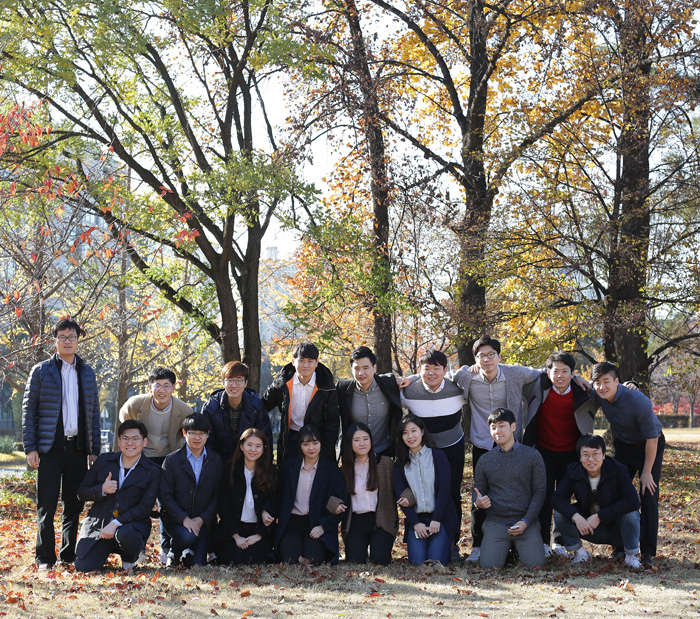
Chemical Engineering KIM, TAE IL Prof.
Future Electronic Devices
Multifunctional Soft Electronics Lab. (Principle investigator: Prof. TaeIl KIM, School of Chemical Engineering) is studying next-generation electronics; flexible electronics, biomimetics, and bio-integrated electronics which have recently attracted attention globally. In particular, the lab are leading worldwide in related researches on brain penetrating electronics (Science, 2013) and spider’s sensory receptor inspired electronics (Nature 2014). The research themes of the laboratory are as follows: 1. Nanofabrication and Biomimetics : The lab can fabricate deep nanoscale and complex 3D patterns like stooped, hierarchical nanopatterns by utilizing various natural forces (such as capillary force, adhesiveness, surface tension, etc.). Based on the techniques, they accomplished many biomimetic applications. 2. Flexible and Bio-Integrated Electronics : The lab has unique techniques for assembling semiconductor devices on a sheet of plastic to get high performance flexible electronics. Moreover, they are conducting a research on bioelectronics that can adhere to human skin or be inserted into the brain and organs.
- No. 35
- 2018-07-05
- 1640
-
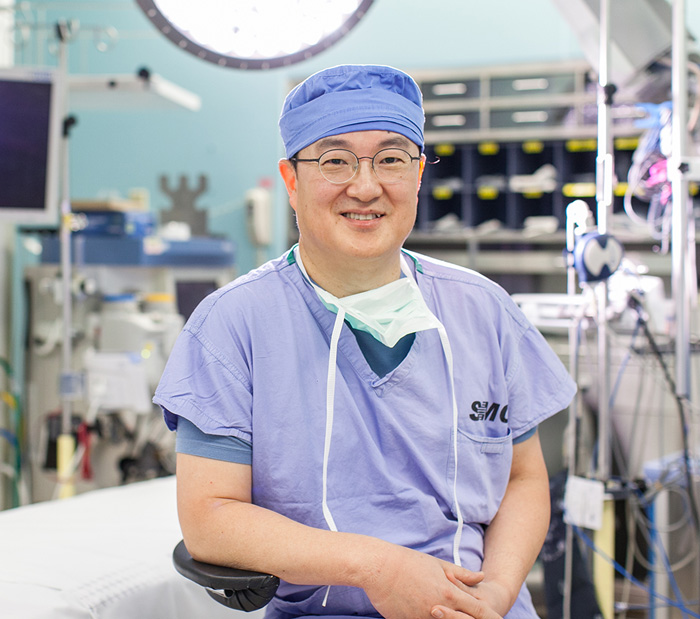
Medicine NAM, DO HYUN Prof.
New Brain Tumor findings from the Analysis of Genomic Mutations and Structure
The research team led by Prof. Do Hyun NAM was selected for the National Research Project by the Ministry of Health and Welfare in 2009 (Institute for Refractory Cancer Research). From that time, the team has been developing the innovative translational research platform, “AVATAR system” which recommends effective therapeutic options for individual patients based on the genomic alterations and drug response profiles (Gene-Drug response Map). To provide the therapeutic recommendation in real time, his research team has streamlined the processes of (1) genomic characterization of patient’s tissue, (2) patient-matched primary cell culture under cancer stem cell culture condition, (3) drug screening using patient derived cell (AVATASCAN®), and (4) drug response validation in the patient derived xenograft model (AVATAR Mouse®). They also developed the (5) software for drug response prediction (AVATAMED) in order to know the sensitivity experienced by the patient from certain chemical treatment. Using the AVATAR system, the team is currently working on genome based patient centered clinical trial for personalized therapy. Through diligent research activities, the research team’s recent major scientific achievements include the analyses of patterns on the genomic mutation depending on the tumor recurrence location (Cancer Cell, 2015) and clonal evolution of glioblastoma under therapy (Nature Genetics, 2016). In addition, research team shows that evolutionary inference from integrated genomic analysis in multisector biopsies can inform targeted therapeutic interventions for patients with brain tumor (Nature Genetics, 2017). By proposing new target therapies for brain tumor patients, his research is receiving great expectation in the hopes of providing treatments that are more precise for brain cancer patient. The team is collaborating with many eminent researchers worldwide to build a global network and try to use such network for establishment of an Initiative for Precision Oncology.
- No. 34
- 2018-07-05
- 1806
-
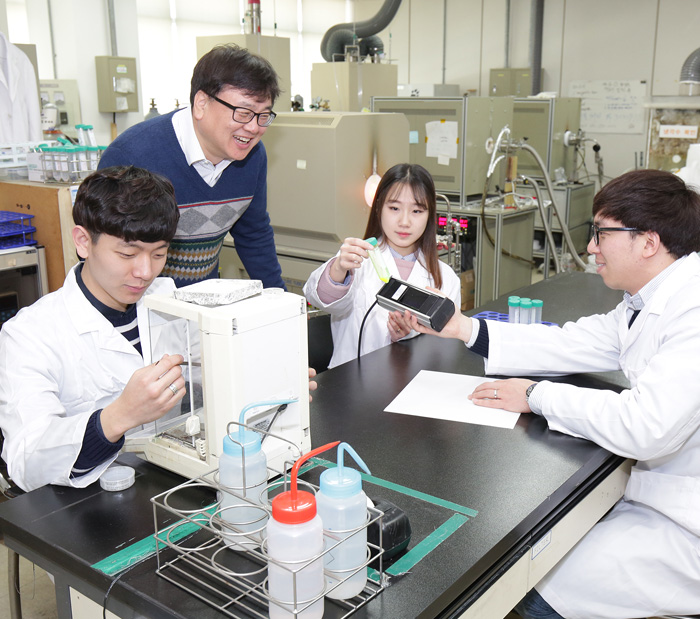
Advanced Materials Science and Engineering YOON, DAEHO Prof.
Production of Nanoparticle & Fabrication of New Materials by Controlling Multifunctional Structure
1. Long-term stable stacked CsPbBr3 quantum dot films for highly efficient white light generation in LEDs. In recent years, how to express colors more vividly and naturally has been raised as a major issue among researchers in the field of display. Producing colors is decided according to the light emitting spectrum of each light emitting diodes (LEDs) presenting red, green, blue. If the light emitting spectrum has narrow full width at half maximum (FWHM), the purity of light emitting material will be improved which can produce more vivid images close to the nature’s colors when applying to display. The research team proposed an efficient and simple method to improve the stability of CsPbBr3 perovskite QDs and developed highly efficient white LED. They successfully prepared fully inorganic CsPbBr3 perovskite QD films as the green-emitting luminescence material for white light generation. This article was published in 2016’s November edition of the world renowned scientific journal, Nanoscale. 2. Mesoporous Ni–Fe oxide multi-composite hollow nanocages for efficient electrocatalytic water oxidation reactions As a clean and sustainable technique, electrochemical water splitting could supply a large-scale hydrogen source. The anode reaction, namely the oxygen evolution reaction (OER) is one of the main steps in electrochemical water splitting. Using a simple two-step hydrothermal method and calcination process, the research team demonstrated the synthesis of mesoporous NiO/NiFe2O4 multi-composite hollow NCs via Ni3[Fe(CN)6]2 PBA nanocube precursors. Such mesoporous NiO/NiFe2O4 multi-composite hollow NCs after 1h of calcination in air at 500°C demonstrate enhanced OER activity with a remarkably low Tafel slope (58.5 mV dec-1), a low over potential of 303 mV at a current density of 10 mA cm2, and excellent cycling stability in alkaline electrolytes, superior to most reported hierarchical structures of binary transition metal oxides/hydroxides. This article was published in the Journal of Materials Chemistry A on 2017’s Feb. 28th.
- No. 33
- 2018-07-05
- 1714
-
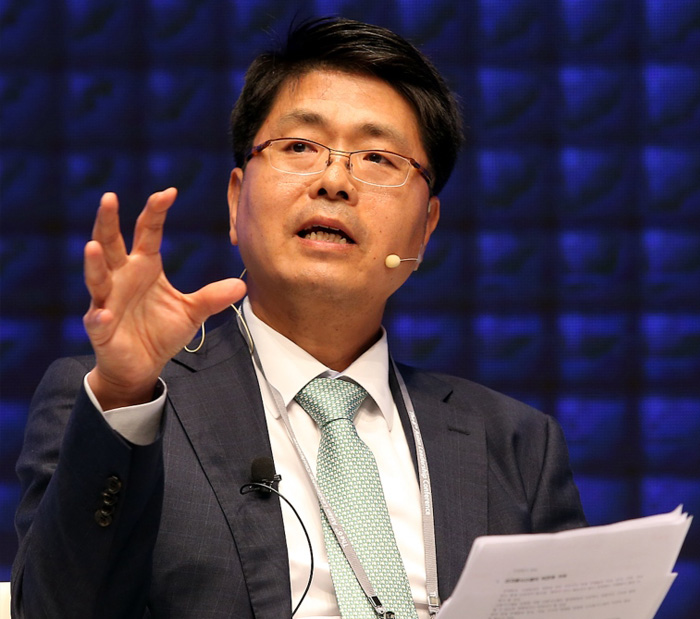
Economics CHO, JOONMO Prof.
Prof. Joon Mo CHO has been chosen for SKKU Fellowship Awardee
Prof. Joon Mo CHO has been chosen for SKKU Fellowship Awardee by publishing 42 research articles in the field of labor economics at SSCI Journal, and receiving recognition for his outstanding performance. There are several researches representing his work over the past 4 years and are introduced as follows: (1) Jobs in the Bureaucratic Afterlife: A Corruption-Facilitating Mechanism Associated with Law Enforcement (with Iljoong Kim), Southern Economic Journal, vol. 68, 2001 This article starts with an observation that the employment of former regulatory officers by a regulated firm might be an integral part of the corruption-facilitating mechanism (CFM). The article hypothesizes that such employment constitutes the deferred payment for the corruption previously supplied. Although anecdotal evidence of this kind of corruption abounds, it has proven difficult to substantiate. The article provides an explanation for why this deferred payment arrangement might be attractive to both demanders and suppliers of corruption. It also offers tentative empirical support for the hypothesis that it plays a role as CFM in Korea, with the implication that this CFM hypothesis can be generalized to a host of regulatory countries. (2) “Why do good performing students highly rate their instructors?”, Economics of Education Review, vol. 49, 2015 This article analyzes the behavior of students in a college classroom with regard to their evaluation of teacher performance. As some students are randomly able to see their grades prior to the evaluation, the “natural” experiment provides a unique opportunity for testing the hypothesis as to whether there exists a possibility of a hedonic (implicit) exchange between the students’ grades and teaching evaluations. Students with good grades tend to highly rate the teaching quality of their instructors, in comparison with those who receive relatively poor grades. This study finds that students with better grades than their predicted grades provide a psychological “gift” to their teachers by giving a higher teacher evaluation; whereas the opposite occurs with those students receiving lower grades than their predictions. These empirical results demonstrate that a previous interpretation on the effect of student grades in an incumbent course with regard to the teaching quality may have to be somewhat discounted. (3) “The impact of epidemics on labor market: Identifying victims of the Middle East Respiratory Syndrome in the Korean labor market”, International Journal for Equity in Health, vol. 15, 2016 The vulnerability approach suggests that disasters such as epidemics have different effects according not only to physical vulnerability, but also to economic class (status). This paper examines the effect of the Middle East Respiratory Syndrome epidemic on the labor market, to investigate whether vulnerable groups become more vulnerable due to an interaction between the socio-economic structure and physical risk. This paper examines the effect of the Middle East Respiratory Syndrome epidemic on the labor market by considering unemployment status, job status, working hours, reasons for unemployment and underemployment status. In particular, the study investigates whether the U-shaped curve becomes a J-shaped curve due to the interaction between medical vulnerability and labor market vulnerability after an outbreak, assuming that the relative vulnerability in the labor market by age shows a U curve with peaks for the young group and middle aged and old aged groups using the Economically Active Population Survey. We use the difference in difference approach and also conduct a falsification check and robustness check. The results suggest that older workers faced a higher possibility of unemployment after the Middle East Respiratory Syndrome outbreak. In particular, they experienced higher involuntary unemployment and underemployment status as well as decreased working hours. It was confirmed that the relative vulnerability of the labor market for older workers was higher than for the other age groups after the epidemic outbreak due to the double whammy of vulnerability in the medical and labor market. The vulnerability in the young group partially increased compared to the 30s and 40s age groups due to their relative vulnerability in the labor market despite being healthy. We find that assuming the relative vulnerability in the existing labor market shows a U shape with age increase, the U-shaped curve became J-shaped after the outbreak. Disasters like epidemics can occur unexpectedly and affect certain groups more than other. Therefore, medical protection should be enhanced for groups vulnerable to disease, and economic measures are also required for the protection of their livelihoods in the labor market to prevent unemployment stemming from inequality.
- No. 32
- 2018-07-05
- 2289
-
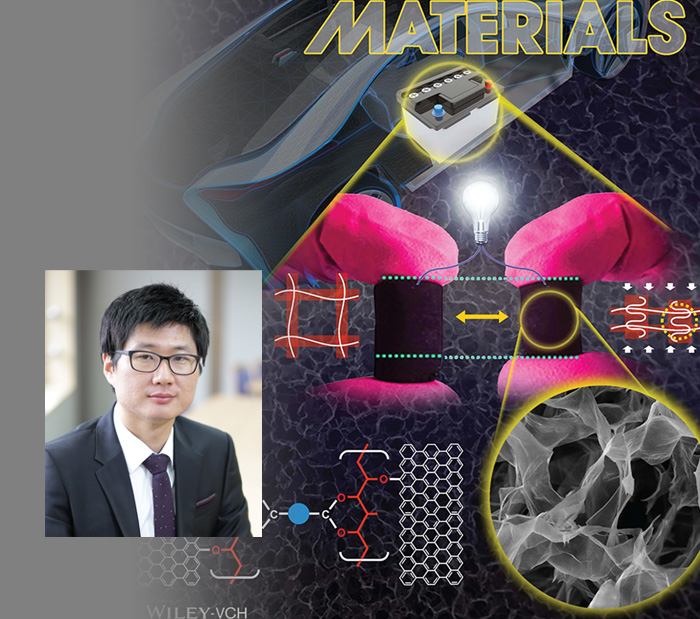
SKKU Advanced Institute of Nano Technology CHO, JEONG HO Prof.
Stretchable and Multimodal All Graphene Electronic Skin
Prof. Jeong Ho CHO’s group (Organic Electronic Device Lab) at SAINT demonstrated all graphene–based transparent and conformable multifunctional E–skin matrix. The CVD–graphene was used as electrodes in the matrix, while graphene oxide (GO) and reduced graphene oxide (rGO) were adopted as sensing materials. A simple lamination process dexterously integrated humidity, temperature, and pressure sensors as a whole. Each sensor was sensitive to its relevant external stimulus, but not affected by the other two stimuli. Moreover, all the sensors can work simultaneously and indicate different stimulations individually. The distributions of the temperature, humidity, and pressure under figure pressing were represented in 2D color mapping. This work suggested a facile fabrication process combined with graphene derivatives to transparent and conformable E–skin application which overcome the conventional complex E–skin fabrication process. Additional sensors and wireless communication units could also be integrated through this simple lamination process, which would greatly help to realize interactive and remote health care in the future. Utilization of various graphene derivatives as main components in E–skin could also open up a way to accelerate the industrialization of graphene. This work was published in Advanced Materials (2016).
- No. 31
- 2018-07-05
- 2032


